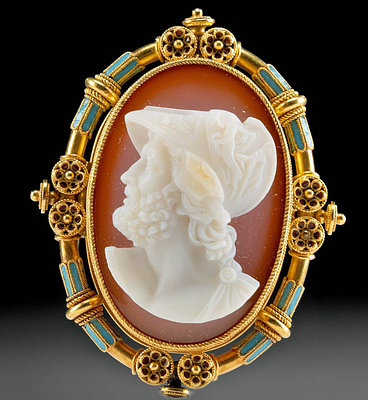Lot of 2 Nazca Gold Tupus - A Stunning Pair!
Lot 105
About Seller
Artemis Gallery
686 S Taylor Ave, Ste 106
Louisville, CO 80027
United States
Selling antiquities, ancient and ethnographic art online since 1993, Artemis Gallery specializes in Classical Antiquities (Egyptian, Greek, Roman, Near Eastern), Asian, Pre-Columbian, African / Tribal / Oceanographic art. Our extensive inventory includes pottery, stone, metal, wood, glass and textil...Read more
Estimate:
$1,700 - $2,550
Absentee vs Live bid
Two ways to bid:
- Leave a max absentee bid and the platform will bid on your behalf up to your maximum bid during the live auction.
- Bid live during the auction and your bids will be submitted real-time to the auctioneer.
Bid Increments
| Price | Bid Increment |
|---|---|
| $0 | $25 |
| $300 | $50 |
| $1,000 | $100 |
| $2,000 | $250 |
| $5,000 | $500 |
| $10,000 | $1,000 |
| $20,000 | $2,500 |
| $50,000 | $5,000 |
| $100,000 | $10,000 |
| $200,000 | $20,000 |
About Auction
By Artemis Gallery
Dec 9, 2021
Set Reminder
2021-12-09 12:00:00
2021-12-09 12:00:00
America/New_York
Bidsquare
Bidsquare : All That Glitters | Ancient & Ethnographic
https://www.bidsquare.com/auctions/artemis-gallery/all-that-glitters-ancient-ethnographic-8000
Join us for a very special holiday auction featuring jewelry, glass, icons, coins, and so much more. Think silver, gold, and all things shiny. Perfect for holiday gift giving or for self-gifting. Artemis Gallery info@artemisgallery.com
Join us for a very special holiday auction featuring jewelry, glass, icons, coins, and so much more. Think silver, gold, and all things shiny. Perfect for holiday gift giving or for self-gifting. Artemis Gallery info@artemisgallery.com
- Lot Description
Pre-Columbian, South Coast Peru, Nazca, ca. 100 to 300 CE. A dazzling pair of golden tupus - ancient Andean versions of brooches or shawl pins - of minimalistic forms. Both stunning implements boast lengthy, slender pins that taper to a sharp points at one end and are topped by double-orbed finials at the other. The larger pin is comprised of 48% gold (equivalent to greater than 11 karats), while the smaller is 55% gold (equivalent to greater than 13 karats). Quality of gold: 48% (11K+) & 55% (13K+); Size of largest: 0.375" W x 6.375" H (1 cm x 16.2 cm); 8.5" H (21.6 cm) on included custom stand; Weight: larger tupu: 4.9 grams, smaller tupu: 2.7 grams
According to Bryan Cockrell, Curatorial Fellow, Arts of Africa, Oceania, and the Americas, 2017 of the Metropolitan Museum of Art, "While the production of tupus has existed over two millennia in the Andes, it is important to recognize the ways in which their use extends beyond 'pins,' and the ways in which scholars have interpreted the uses of these objects. 'Tupu' (also spelled 'topu' or 'topo') could refer to a pin, but also to a measurement. In the ayllu, or local community, of Qaqachaka in Bolivia, tupus are currently used to make agricultural measurements, level out earth, build irrigation canals, and mark the boundaries of territories (Fernandez 2015, 11). Alternatively, Rinque (2012, 13) ascribes the meaning of tupu as measurement 'to the standard used in exchanging the valuable dyes people used for wool' ('al patron utilizado para el intercambio de las valiosas tinturas para el tenido de la lana'). It is interesting to recognize this last meaning of 'tupu' considering that many tupus appear to have been prepared from stock metal. Furthermore, this raises the question of how the metal used to make them was part of a wider network of exchange. Rinque (2012, 13) notes that Aymara and Mapuche peoples have historically traded dyes for other materials, including minerals."
Provenance: private Hawaii, USA collection; ex-Gary Drimmer collection, Chicago, Illinois, USA, acquired from 1950 to 1960
All items legal to buy/sell under U.S. Statute covering cultural patrimony Code 2600, CHAPTER 14, and are guaranteed to be as described or your money back.
A Certificate of Authenticity will accompany all winning bids.
PLEASE NOTE: Due to recent increases of shipments being seized by Australian & German customs (even for items with pre-UNESCO provenance), we will no longer ship most antiquities and ancient Chinese art to Australia & Germany. For categories of items that are acceptable to ship to Australia or Germany, please contact us directly or work with your local customs brokerage firm.
Display stands not described as included/custom in the item description are for photography purposes only and will not be included with the item upon shipping.
#161534Light bending to body and indentations to finial of larger pin. Otherwise, both are intact and excellent.Condition
- Shipping Info
-
All shipping is handled in-house for your convenience. Your invoice from Artemis Gallery will include shipping calculation instructions. If in doubt, please inquire BEFORE bidding for estimated shipping costs for individual items.
-
- Buyer's Premium



 EUR
EUR CAD
CAD AUD
AUD GBP
GBP MXN
MXN HKD
HKD CNY
CNY MYR
MYR SEK
SEK SGD
SGD CHF
CHF THB
THB













